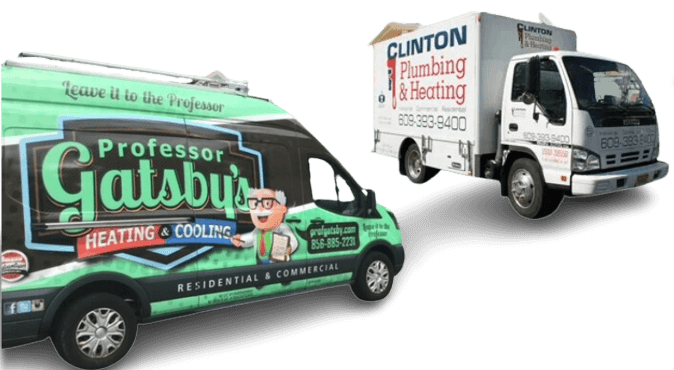




Heating, Air Conditioning & Plumbing Repair, Maintenance, and Installation in South Jersey
Why Hire Us for Your Heating and AC Needs
Speedy Service
When your heating or air conditioning system malfunctions, you want things fixed as quickly as possible, right? As a result, the Professor’s fleet visits homes and families throughout South Jersey. Our experienced technicians arrive with fully stocked vehicles to get you back up and running quickly.
We Earn Your Trust
Yes, we are quick, but our pros are keen on details. They’ll go through everything with you to ensure you know what went wrong, why it happened and give you the best advice to repair. Customers tell us that they have never been treated more professionally and sensibly by a company. Only Professor Gatsby’s Heating and Cooling will give you that feeling of assurance and care. We are proud to stand behind our work with a 100% satisfaction guarantee!
We Are The Experts in Comfort Repair
Professor Gatsby’s expertise in both commercial and residential HVAC systems, we provide reliable and efficient repair solutions to keep your business running smoothly. Our HVAC services are straightforward. If it’s broken, we can fix it. If it’s working, we can maintain it. If it’s obsolete, we can replace it. And as for our work, we guarantee it.
5 STARS – 1 Reason
Although there may be many options, how we handle our customers sets us apart from the competition. We place a high value on the satisfaction of our clients, as seen by our 5-STAR RATINGS. For every HVAC service we provide, we only employ the best and most experienced professionals, delighting our clients.



Proudly Serving These
South Jersey Areas,
Proudly Serving These
South Jersey Areas,
Our Specials
Heating
All kinds of heating systems must be carefully selected and installed only by well-experienced professionals. Experts can recommend reliable brands and install the units according to industry standards. Letting professionals do the technical work will ensure the proper functioning of the entire heating system.
A/C
Everyone desires a cozy living space, especially when they are at home and want to unwind. Thanks to modern technology, it is now simpler than ever to maintain a suitable indoor temperature, regardless of the outside weather.


The Professor Does It All!


What People Say About Us
24/7 Emergency Service Available
Get in Touch
Latest Blogs


Benefits of Variable Speed Air Conditioners
Basics of single stage air conditioning Most American homes with central air conditioning use a single stage compressor. These compressors were standard for decades, and


Stay Allergy-Free: Managing Indoor Allergens During the Summer Months
While summer brings warm weather and outdoor adventures, it also heralds the arrival of allergens that can wreak havoc on allergy sufferers. Contrary to popular


Top Things that could be wrong with your air conditioner
My Air Conditioner isn’t working, what could be wrong? Is your air conditioner not working properly? It can be frustrating when your AC isn’t keeping






